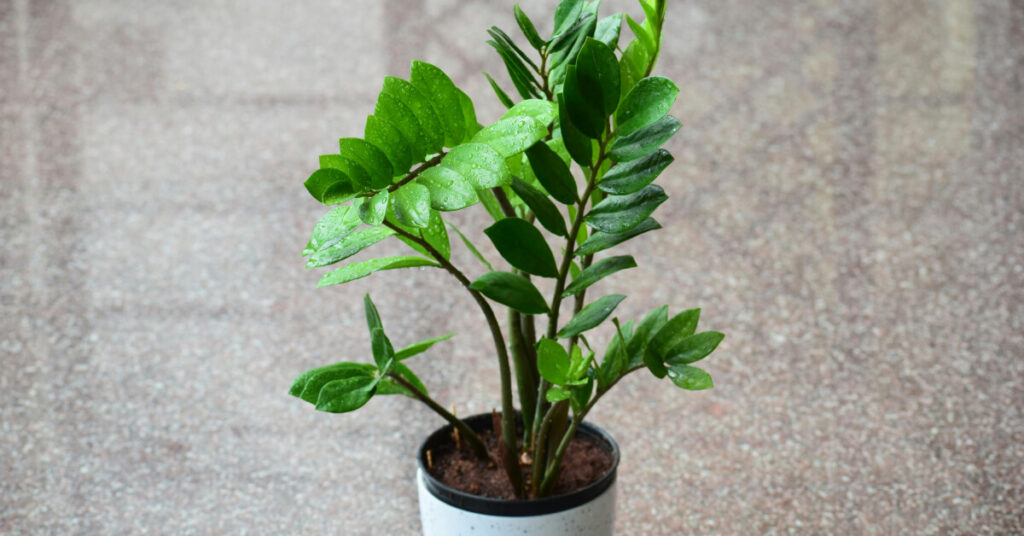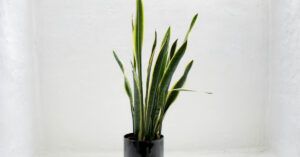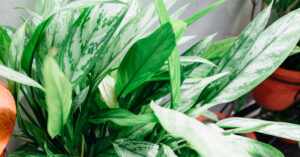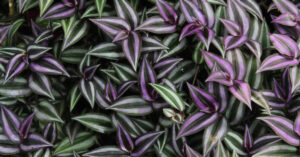Zamioculcas zamiifolia
ZZ Plant stands as the ultimate survivor in the houseplant world, earning its reputation as virtually indestructible while delivering stunning architectural beauty that complements any modern interior. This remarkable specimen combines glossy, sculptural foliage with supernatural tolerance for neglect, making it the perfect choice for anyone seeking sophisticated greenery without the commitment of regular plant care.
Why ZZ Plant Is Every Plant Parent’s Safety Net
Native to the drought-prone regions of eastern Africa, Zamioculcas zamiifolia has evolved extraordinary survival mechanisms that make it nearly impossible to kill through neglect. Its thick, waxy leaves store water efficiently while its substantial underground rhizomes act as backup water reservoirs, allowing the plant to survive extended periods without attention. The plant’s naturally glossy, architectural foliage creates a modern, sophisticated presence that works beautifully in contemporary spaces, offices, and minimalist interiors.
What makes ZZ Plant truly exceptional is its ability to thrive in conditions that would challenge or kill most houseplants. It tolerates low light, irregular watering, dry air, and temperature fluctuations while maintaining its elegant appearance year-round. NASA studies have recognized ZZ Plant as an effective air purifier, removing xylene, toluene, and benzene from indoor air, making it both beautiful and beneficial for your home environment.
Care Requirements
Light Requirements
Low to bright indirect light
ZZ Plant demonstrates unmatched adaptability to virtually any lighting condition, making it invaluable for difficult spaces where other plants would struggle. It thrives equally well in bright, indirect light and low-light conditions, including offices with only fluorescent lighting, north-facing windows, and interior rooms with minimal natural light. The plant maintains its glossy, deep green appearance regardless of light levels, though growth may be slightly slower in very dim conditions. Direct sunlight can scorch the leaves, but this is one of the few ways to actually damage this resilient plant.
Watering
Low frequency
The golden rule for ZZ Plant care is simple: when in doubt, don’t water. This drought-adapted plant stores water in its thick leaves and substantial rhizomes, allowing it to survive weeks or even months without watering. Water only when the soil is completely dry throughout the pot, typically every 2-4 weeks during growing season and even less frequently in winter. The plant actually prefers to dry out completely between waterings, and overwatering is virtually the only way to harm this indestructible specimen.
Soil Type
Well-draining, fast-draining potting mix
Excellent drainage is absolutely critical for ZZ Plant success, as this is the one area where the plant shows no tolerance for poor conditions. Use a cactus and succulent potting mix, or create your own by mixing regular potting soil with perlite, coarse sand, or pumice in a 1:1 ratio. The soil should drain quickly and completely, never remaining soggy or waterlogged. Choose pots with drainage holes—this cannot be compromised for ZZ Plant health.
Temperature
65-85°F (18-29°C)
ZZ Plant adapts remarkably well to a wide range of temperatures and tolerates fluctuations that would stress other houseplants. It thrives in typical household temperatures between 65-85°F but can handle brief periods outside this range without damage. The plant shows impressive resilience to both warm and cool conditions, making it perfect for offices, homes with varying temperatures, and spaces with less-than-ideal climate control.
Humidity
Any
ZZ Plant requires absolutely no special humidity considerations, thriving equally well in dry and humid environments. It performs excellently in the dry air of heated homes, air-conditioned offices, and arid climates without any additional moisture. This complete humidity tolerance makes it perfect for any environment and eliminates one of the most common houseplant care challenges.
Fertilizing
Minimal feeding
ZZ Plant has virtually no fertilizer requirements and can thrive indefinitely without any feeding. If you choose to fertilize, apply a diluted liquid fertilizer 2-3 times per year during the growing season, but this is entirely optional. Over-fertilizing can actually harm the plant by promoting weak, rapid growth that compromises its natural resilience. The plant’s slow growth means it simply doesn’t require the regular nutrition that faster-growing plants demand.
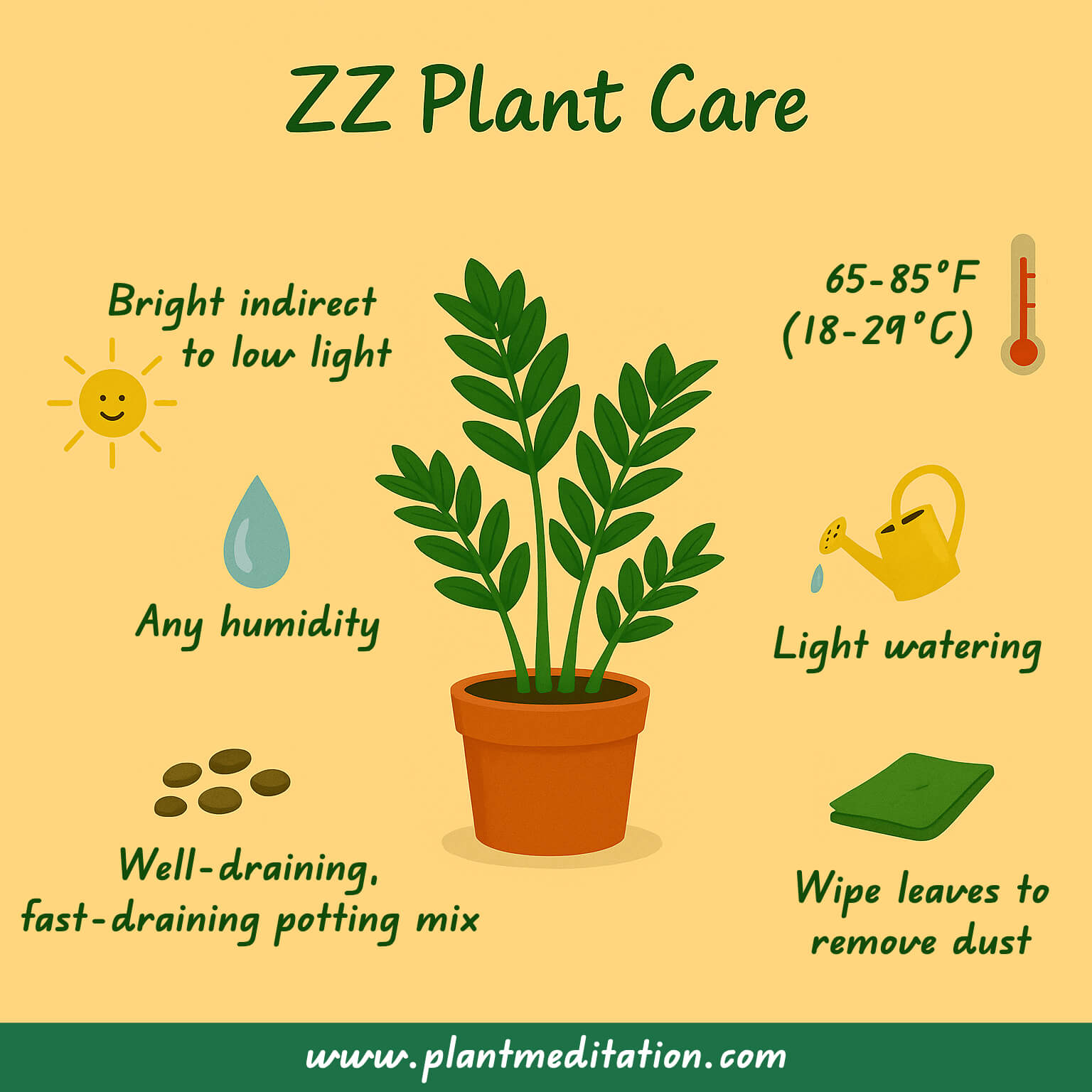
Seasonal Care Adjustments
Spring/Summer (Growing Season):
- Water every 2-4 weeks when soil is completely dry
- Optional light fertilizing 2-3 times total
- Ideal time for repotting if absolutely necessary
- Monitor for new growth shoots emerging from soil
Fall/Winter (Slower Growth):
- Reduce watering to every 4-8 weeks or longer
- No fertilizing needed
- Growth naturally slows to nearly stopped—this is completely normal
- Perfect time to enjoy the plant’s low-maintenance nature
Mature Size and Growth Habits
ZZ Plant typically reaches 2-3 feet in height and width when mature, maintaining an elegant, upright form that works beautifully as a floor plant or substantial tabletop specimen. The plant grows very slowly, often taking 3-5 years to reach full size, which means it maintains its proportions for years without outgrowing its space or requiring frequent repotting. Individual stems, called rachis, emerge directly from underground rhizomes and can reach 2-4 feet long, creating the plant’s characteristic architectural appearance. With minimal care, ZZ Plants can live for decades, often becoming treasured, virtually maintenance-free specimens.
Difficulty Level
Very easy
ZZ Plant ranks as one of the easiest houseplants in existence, requiring minimal attention while tolerating significant neglect. It’s perfect for beginners, frequent travelers, busy professionals, and anyone who wants beautiful plants without regular maintenance commitments.
Pet and Child Safety
Important: ZZ Plant is toxic to pets and children if ingested. The plant contains calcium oxalate crystals that can cause mouth irritation, difficulty swallowing, and digestive upset. Additionally, the plant’s sap can cause skin irritation in sensitive individuals. Keep ZZ Plants out of reach of curious pets and small children, and wash hands after handling the plant, especially during repotting or propagation.
Varieties to Consider
While the classic green ZZ Plant remains most popular, several striking varieties offer unique visual appeal:
- Zamioculcas zamiifolia ‘Raven’: Nearly black foliage that emerges green and darkens with age
- Zamioculcas zamiifolia ‘Zenzi’: Compact dwarf variety perfect for small spaces
- Zamioculcas zamiifolia ‘Lucky Classic’: Traditional variety with extra glossy leaves
- Zamioculcas zamiifolia ‘Zamicro’: Miniature version ideal for desks and small containers
Plants That Pair Well with ZZ Plant
ZZ Plant’s architectural form and extremely low maintenance requirements make it an excellent anchor plant for any collection. Its glossy, structured appearance provides beautiful contrast while thriving in conditions that challenge other plants.
Perfect Companions:
- Snake Plant – Equally indestructible with complementary upright form
- Chinese Evergreen – Similar low-light tolerance with colorful foliage contrast
- Rubber Plant – Comparable architectural presence with different leaf texture
- Peace Lily – Contrasting care needs but complementary modern aesthetic
- Aloe Vera – Fellow drought-tolerant plant with different growth habit
Low-Maintenance Collections: Create stunning, nearly carefree plant displays by combining ZZ Plant with other drought-tolerant, low-light plants like snake plants, Chinese evergreens, and cast iron plants. These combinations require minimal attention while providing maximum visual impact.
Aesthetic Pairings: ZZ Plant serves as an excellent structural element in plant groupings, providing height, substance, and modern appeal while allowing more delicate plants to shine. Its glossy, architectural foliage creates beautiful contrast with softer, trailing plants or colorful flowering specimens.
Common Problems and Solutions
Overwatering
Symptoms: Yellow leaves, mushy stems, root rot, moldy soil, rhizome deterioration
Solution: Stop watering immediately, improve drainage, remove affected parts, repot if necessary
Underwatering (Rare)
Symptoms: Wrinkled stems, extremely dry soil, stunted growth
Solution: Water thoroughly and wait for soil to dry completely before next watering
Too Much Direct Sun
Symptoms: Scorched leaves with brown patches, faded color
Solution: Move to bright indirect light location
Pest Issues (Uncommon)
Symptoms: Scale insects, spider mites (rare due to plant’s natural resistance)
Solution: Regular inspection, neem oil treatment if needed
Normal Leaf Drop
Symptoms: Occasional yellowing and dropping of older leaves
Solution: This is natural aging – simply remove yellowed leaves
Propagation
ZZ Plant propagation is possible but requires patience due to the plant’s naturally slow growth rate. However, the process is straightforward and rewarding:
Leaf Cutting Method:
- Remove healthy leaflets from mature stems
- Allow cut surfaces to dry for 24-48 hours
- Plant leaflets in well-draining soil mix
- Keep lightly moist (not wet) in bright, indirect light
- Roots and tiny plantlets develop in 2-4 months
- Transplant once new growth is established (6-12 months total)
Division Method:
- Remove entire plant from pot during repotting
- Gently separate rhizomes with roots and stems attached
- Allow cut surfaces to dry for 24 hours
- Plant divisions in fresh, well-draining soil
- Water sparingly until new growth appears
Rhizome Cutting:
- Cut sections of rhizome with at least one growing point
- Allow to dry for 24-48 hours
- Plant in well-draining mix and keep lightly moist
- New shoots emerge in 2-3 months
Troubleshooting Slow Growth
While ZZ Plant’s slow growth is completely normal, several factors can optimize its development rate within its natural limitations.
Light Optimization: Providing bright, indirect light encourages the fastest growth possible while maintaining the plant’s resilience. Avoid low light if faster growth is desired.
Proper Watering Cycle: Allowing complete drying between thorough waterings promotes healthy root development and steady growth.
Adequate Space: Slightly root-bound conditions are fine, but extremely cramped roots can slow growth further. Repot every 3-4 years or when absolutely necessary.
Temperature Consistency: Maintaining steady warm temperatures promotes more active growth during the growing season.
Patience: Remember that ZZ Plant’s slow growth is a feature, not a flaw—it contributes to the plant’s incredible durability and low maintenance requirements.
Your Foolproof Plant Success Story
ZZ Plant represents the perfect insurance policy for anyone wanting guaranteed houseplant success without ongoing commitment. Its combination of striking architectural beauty, supernatural resilience, and air-purifying benefits makes it an invaluable addition to homes, offices, and any space needing reliable greenery that thrives on neglect.
Whether you’re a complete beginner afraid of killing plants, a frequent traveler needing low-maintenance beauty, or an experienced plant parent seeking a foolproof specimen, ZZ Plant delivers unwavering success with minimal effort. Start with this indestructible beauty, and you’ll discover the confidence that comes from having a plant that truly thrives when left alone—the ultimate expression of low-maintenance luxury in the plant world.

